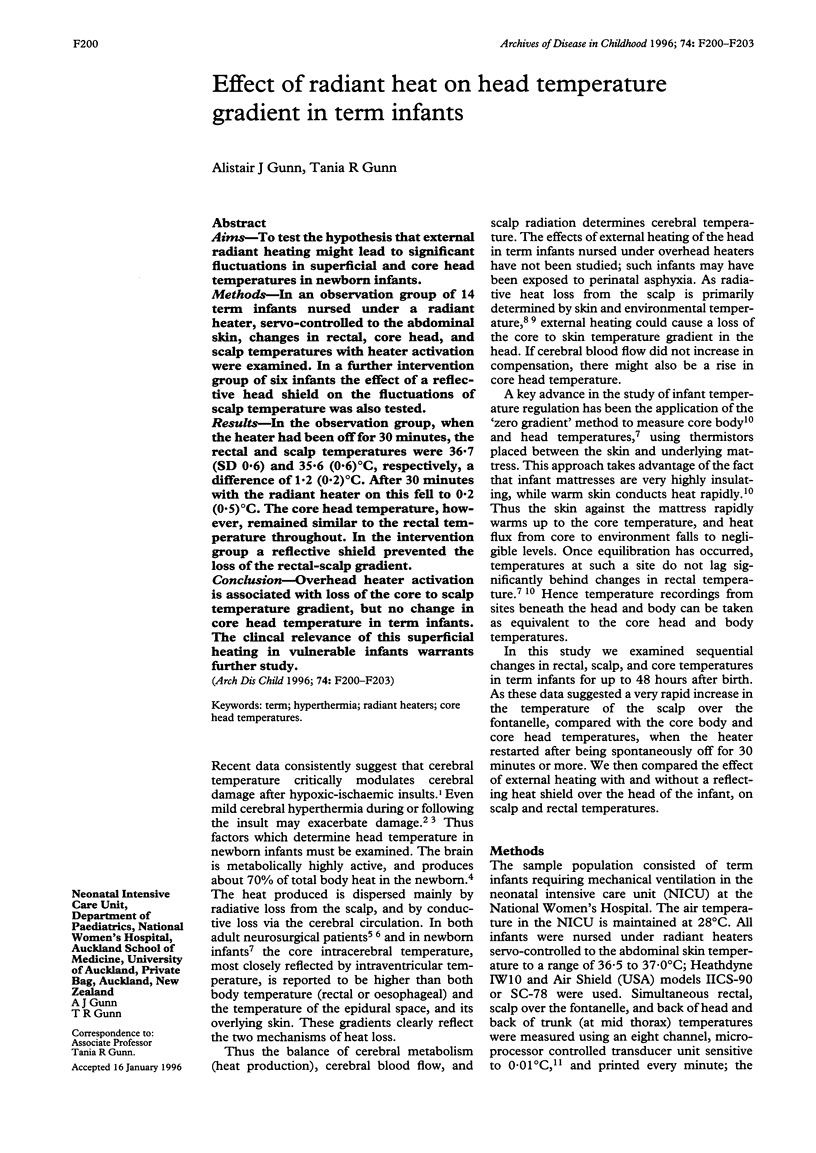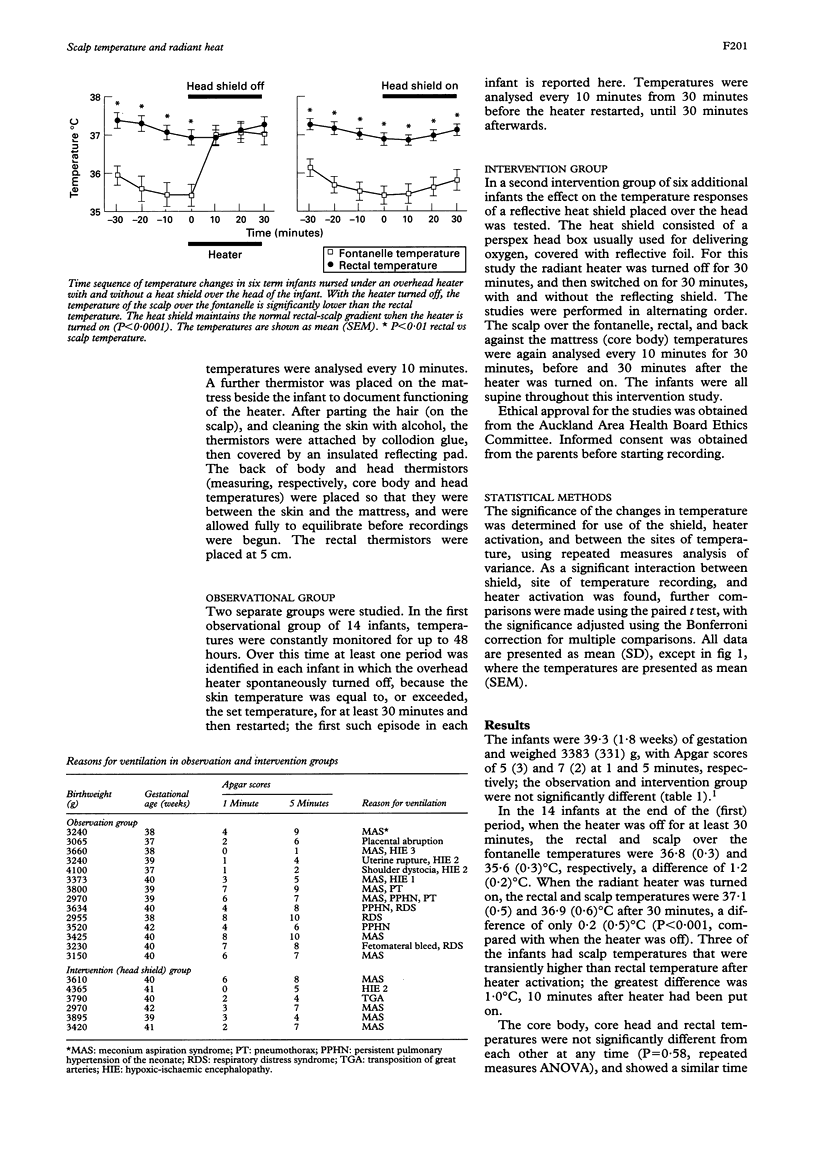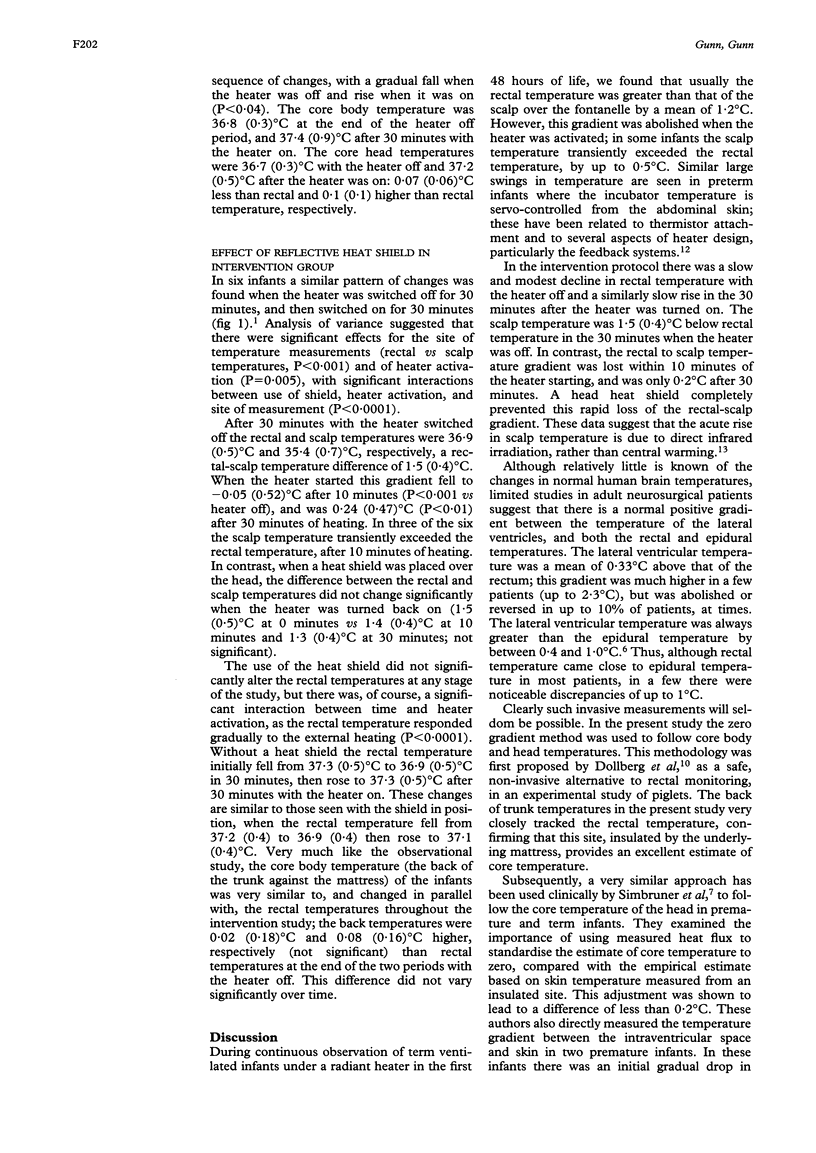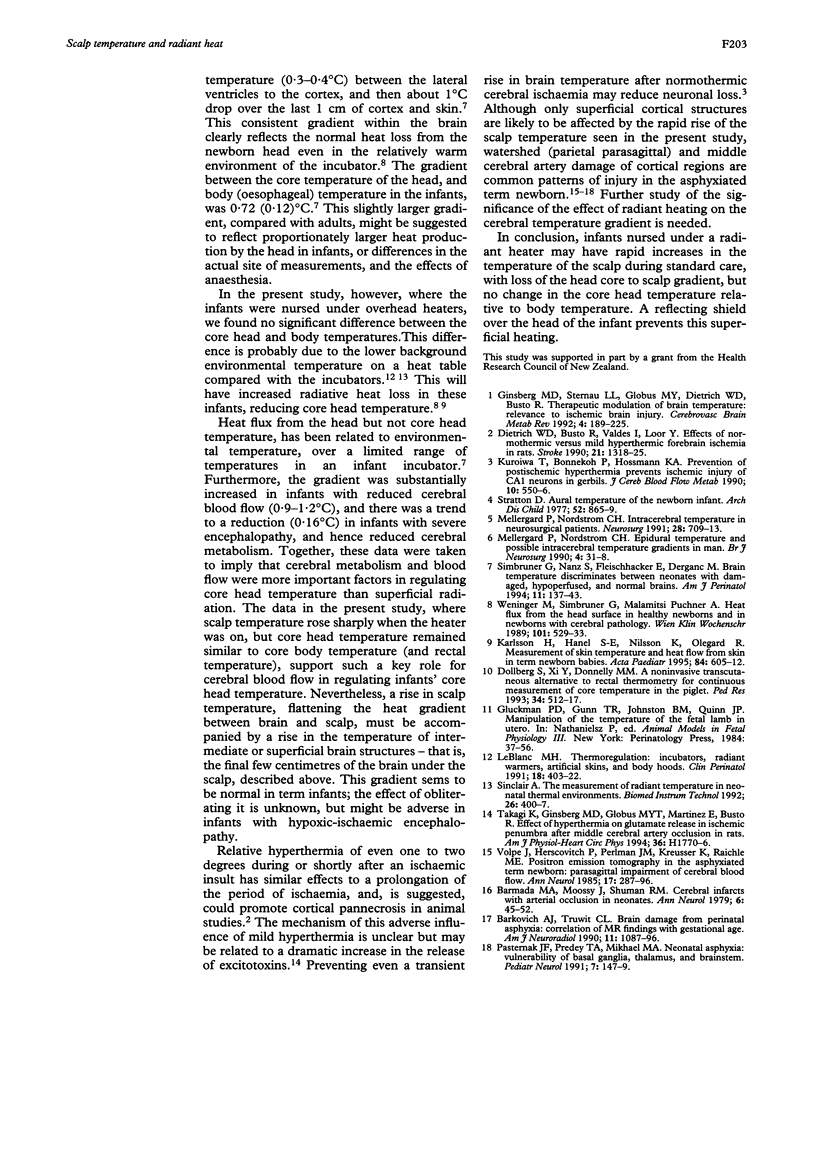Abstract
AIMS: To test the hypothesis that external radiant heating might lead to significant fluctuations in superficial and core head temperatures in newborn infants. METHODS: In an observation group of 14 term infants nursed under a radiant heater, servo-controlled to the abdominal skin, changes in rectal, core head, and scalp temperatures with heater activation were examined. In a further intervention group of six infants the effect of a reflective head shield on the fluctuations of scalp temperature was also tested. RESULTS: In the observation group, when the heater had been off for 30 minutes, the rectal and scalp temperatures were 36.7 (SD 0.6) and 35.6 (0.6) degrees C, respectively, a difference of 1.2 (0.2) degrees C. After 30 minutes with the radiant heater on this fell to 0.2 (0.5) degrees C. The core head temperature, however, remained similar to the rectal temperature throughout. In the intervention group a reflective shield prevented the loss of the rectal-scalp gradient. CONCLUSION: Overhead heater activation is associated with loss of the core to scalp temperature gradient, but no change in core head temperature in term infants. The clinical relevance of this superficial heating in vulnerable infants warrants further study.
Full text
PDF



Selected References
These references are in PubMed. This may not be the complete list of references from this article.
- Barkovich A. J., Truwit C. L. Brain damage from perinatal asphyxia: correlation of MR findings with gestational age. AJNR Am J Neuroradiol. 1990 Nov-Dec;11(6):1087–1096. [PMC free article] [PubMed] [Google Scholar]
- Dietrich W. D., Busto R., Valdes I., Loor Y. Effects of normothermic versus mild hyperthermic forebrain ischemia in rats. Stroke. 1990 Sep;21(9):1318–1325. doi: 10.1161/01.str.21.9.1318. [DOI] [PubMed] [Google Scholar]
- Dollberg S., Xi Y., Donnelly M. M. A noninvasive transcutaneous alternative to rectal thermometry for continuous measurement of core temperature in the piglet. Pediatr Res. 1993 Oct;34(4):512–517. doi: 10.1203/00006450-199310000-00026. [DOI] [PubMed] [Google Scholar]
- Ginsberg M. D., Sternau L. L., Globus M. Y., Dietrich W. D., Busto R. Therapeutic modulation of brain temperature: relevance to ischemic brain injury. Cerebrovasc Brain Metab Rev. 1992 Fall;4(3):189–225. [PubMed] [Google Scholar]
- Karlsson H., Hänel S. E., Nilsson K., Olegård R. Measurement of skin temperature and heat flow from skin in term newborn babies. Acta Paediatr. 1995 Jun;84(6):605–612. doi: 10.1111/j.1651-2227.1995.tb13708.x. [DOI] [PubMed] [Google Scholar]
- Kuroiwa T., Bonnekoh P., Hossmann K. A. Prevention of postischemic hyperthermia prevents ischemic injury of CA1 neurons in gerbils. J Cereb Blood Flow Metab. 1990 Jul;10(4):550–556. doi: 10.1038/jcbfm.1990.97. [DOI] [PubMed] [Google Scholar]
- LeBlanc M. H. Thermoregulation: incubators, radiant warmers, artificial skins, and body hoods. Clin Perinatol. 1991 Sep;18(3):403–422. [PubMed] [Google Scholar]
- Mellergård P., Nordström C. H. Epidural temperature and possible intracerebral temperature gradients in man. Br J Neurosurg. 1990;4(1):31–38. doi: 10.3109/02688699009000679. [DOI] [PubMed] [Google Scholar]
- Mellergård P., Nordström C. H. Intracerebral temperature in neurosurgical patients. Neurosurgery. 1991 May;28(5):709–713. [PubMed] [Google Scholar]
- Pasternak J. F., Predey T. A., Mikhael M. A. Neonatal asphyxia: vulnerability of basal ganglia, thalamus, and brainstem. Pediatr Neurol. 1991 Mar-Apr;7(2):147–149. doi: 10.1016/0887-8994(91)90014-c. [DOI] [PubMed] [Google Scholar]
- Simbruner G., Nanz S., Fleischhacker E., Derganc M. Brain temperature discriminates between neonates with damaged, hypoperfused, and normal brains. Am J Perinatol. 1994 Mar;11(2):137–143. doi: 10.1055/s-2007-994574. [DOI] [PubMed] [Google Scholar]
- Sinclair A. The measurement of radiant temperature in neonatal thermal environments. Biomed Instrum Technol. 1992 Sep-Oct;26(5):400–407. [PubMed] [Google Scholar]
- Stratton D. Aural temperature of the newborn infant. Arch Dis Child. 1977 Nov;52(11):865–869. doi: 10.1136/adc.52.11.865. [DOI] [PMC free article] [PubMed] [Google Scholar]
- Volpe J. J., Herscovitch P., Perlman J. M., Kreusser K. L., Raichle M. E. Positron emission tomography in the asphyxiated term newborn: parasagittal impairment of cerebral blood flow. Ann Neurol. 1985 Mar;17(3):287–296. doi: 10.1002/ana.410170312. [DOI] [PubMed] [Google Scholar]
- Weninger M., Simbruner G., Malamitsi-Puchner A. Heat flux from the head surface in healthy newborns and in newborns with cerebral pathology. Wien Klin Wochenschr. 1989 Sep 1;101(16):529–533. [PubMed] [Google Scholar]


